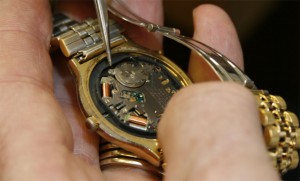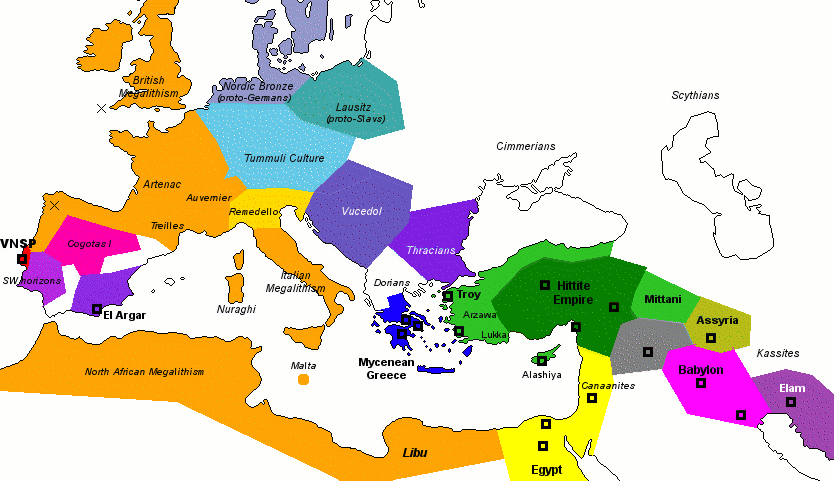An excellent new study on mtDNA haplogroup U6 has been published this week:
Bernard Sechel et al., The history of the North African mitochondrial DNA haplogroup U6 gene flow into the African, Eurasian and American continents. BMC Evolutionary Biology 2014. Open access → LINK [doi:10.1186/1471-2148-14-109]
Abstract (provisional)
Background
Complete mitochondrial DNA (mtDNA) genome analyses have greatly improved the phylogeny and phylogeography of human mtDNA. Human mitochondrial DNA haplogroup U6 has been considered as a molecular signal of a Paleolithic return to North Africa of modern humans from southwestern Asia.
Results
Using 230 complete sequences we have refined the U6 phylogeny, and improved the phylogeographic information by the analysis of 761 partial sequences. This approach provides chronological limits for its arrival to Africa, followed by its spreads there according to climatic fluctuations, and its secondary prehistoric and historic migrations out of Africa colonizing Europe, the Canary Islands and the American Continent.
Conclusions
The U6 expansions and contractions inside Africa faithfully reflect the climatic fluctuations that occurred in this Continent affecting also the Canary Islands. Mediterranean contacts drove these lineages to Europe, at least since the Neolithic. In turn, the European colonization brought different U6 lineages throughout the American Continent leaving the specific sign of the colonizers origin.
 |
| Figure 1 Surface maps, based on HVI frequencies (in o/oo), for total U6 (U6), total U6a (Tot U6a), U6a without 16189 (U6a), U6a with 16189 (U6a-189), U6b'd, U6c, U6b and U6d. |
U6 can be considered a somewhat strange haplogroup. While it is derived from U (and hence from R and N), which has an Asian origin, it seems to have expanded from NW Africa, more specifically from the Northern mountainous areas of the Moroccan state, a country known as Rif or in the native Tamazigh language Arif (of which Rif is an Arabized version), not the usual place one tends to imagine as the origin of any human expansion wave.
Actually there is at least one important cultural expansion from that area: the Oranian or Iberomaurusian culture of the Mid-to-Late Upper Paleolithic. To some extent at least the expansion of this lineage is probably associated to this ancient culture.
Whatever the case, U6 is not a common haplogroup: its highest peak in frequency is in the Canary Islands (16%), followed by North-West Africa (5-9%). Then come Portugal and its insular colonies, as well as Cape Verde and Ethiopia (~3%) and then there is some scatter in Spain, West Africa, NE Africa and peninsular Arabia (~1%), as well as in some other parts of Europe, Africa and West Asia (<1%).
On the other hand it is one of the four basal branches of the major West Eurasian haplogroup U (U5 and U2'3'4'7'8'9 are more common, while U1 is even rarer and less studied), so understanding U6 seems important to better understand its parent lineage.
Therefore this new study with its great wealth of detail and care is much welcome.
Chronological estimates and expansion patterns of U6
It may surprise you that I am even in tentative agreement with the chronological estimates for U6 and its subclades, listed in tables 2 and 3. But it is for a good reason: they make sense (assuming a reasonable CI). And the fact that they seem to make sense is probably because the authors took great care to calibrate the ages for this lineage, using as main (but not only) reference a Canadian derived lineage that seems to be a colonial founder effect.
Anyhow all these dates should be considered as center-points of a variably wider range of possibilities, the so-called confidence interval (CI) or error margin (em). If we do that, as we should, we get the "power" to stretch the figures forth and back as need be to some extent without losing consistency, and that alone should be enough to get the estimates fit better with the material evidence (archaeology mostly).
The authors actually mention some of those CIs in a lengthy section dedicated to explore the possible patterns of U6 spread in Africa and elsewhere.
Interestingly they suggest that the first radiation of U6 took place from NW Africa in largely eastwards direction, belonging almost necessarily to the Iberomaurusian (Oranian) culture:
This first African expansion of U6a in the Maghreb was suggested in a previous analysis [6]. This radiation inside Africa occurred in Morocco around 26 kya (Table 2) and, ruling out the earlier Aterian, we suggested the Iberomaurusian as the most probable archaeological and anthropological correlate of this spread in the Maghreb [6]. Others have pointed to the Dabban industry in North Africa and its supposed source in the Levant, the Ahmarian, as the archaeological footprints of U6 coming back to Africa [7,9]. However, we disagree for several reasons: firstly, they most probably evolved in situ from previous cultures, not being intrusive in their respective areas [42-44]; second, their chronologies are out of phase with U6 and third, Dabban is a local industry in Cyrenaica not showing the whole coastal expansion of U6. In addition, recent archaeological evidence, based on securely dated layers, also points to the Maghreb as the place with the oldest implantation of the Iberomaurusian culture [45], which is coincidental with the U6 radiation from this region proposed in this and previous studies [6].
Some millennia later, U62 appears to expand in Ethiopia, while, as mentioned, U6a1 does the same in Europe (mostly Western Iberia) and other sister lineages do the same in NW Africa itself.
A second wave of radiation corresponds to the early Holocene:
Basic clusters like U6b, U6c and U6d also emerged within a window between 13 to 10 kya (Table 2). U6b lineages spread from the Maghreb, through the Sahel, to West Africa and the Canary Islands (U6b1a), and are also present from the Sudan to Arabia, but not detected in Ethiopia. In contrast, U6c and U6d are more localized in the Maghreb. Further spreads of secondary U6a branches are also apparent, going southwards to Sahel countries and reaching West Africa (U6a5a). Autochthonous clusters in sub-Saharan Africa first appeared at around 7 kya (U6a5b), coinciding with a period of gradual desiccation that would have obliged pastoralists to abandon many desert areas [52]. Consequently, no more U6 lineages in the Sahel are detected, while later expansions continued in West Africa (U6a3f, U6a3c, and U6b3) and the Maghreb with an additional spread to the Mediterranean shores of Europe involving U6b2, U6a3e, U6a1b and U6a3b1.
For easier understanding of the U6 phylogeny and its sometimes hard to interpret migration patterns, I made up the following graph, based on the supplemental material of this study:
 |
U6 phylogeny, color coded by regions:
|
I must say that, I have some doubts about the exact origins of several subhaplogroups, notably:
- U6a is so diverse in some branches that it is difficult to identify it as unmistakably of NW African origin. NW Africa still gets the greatest weight (3/7) but not a clear majority.
- In U6b Tropical African lineages weight 4.5/10, while NW African ones weight only 3/10. It is a good candidate for expansion from the "Wet Sahara" indeed.
- In U6c1 European and NW African lineages weight exactly the same, although I guess that it may be reasonable to imagine Andalusian U6c1c as derived from North Africa.
However overall U6, as well as its derived lineages U6b'd and U6c clearly originated in NW Africa, so I understand that, when unclear, NW Africa gets the benefit of doubt for the derived origins.






















